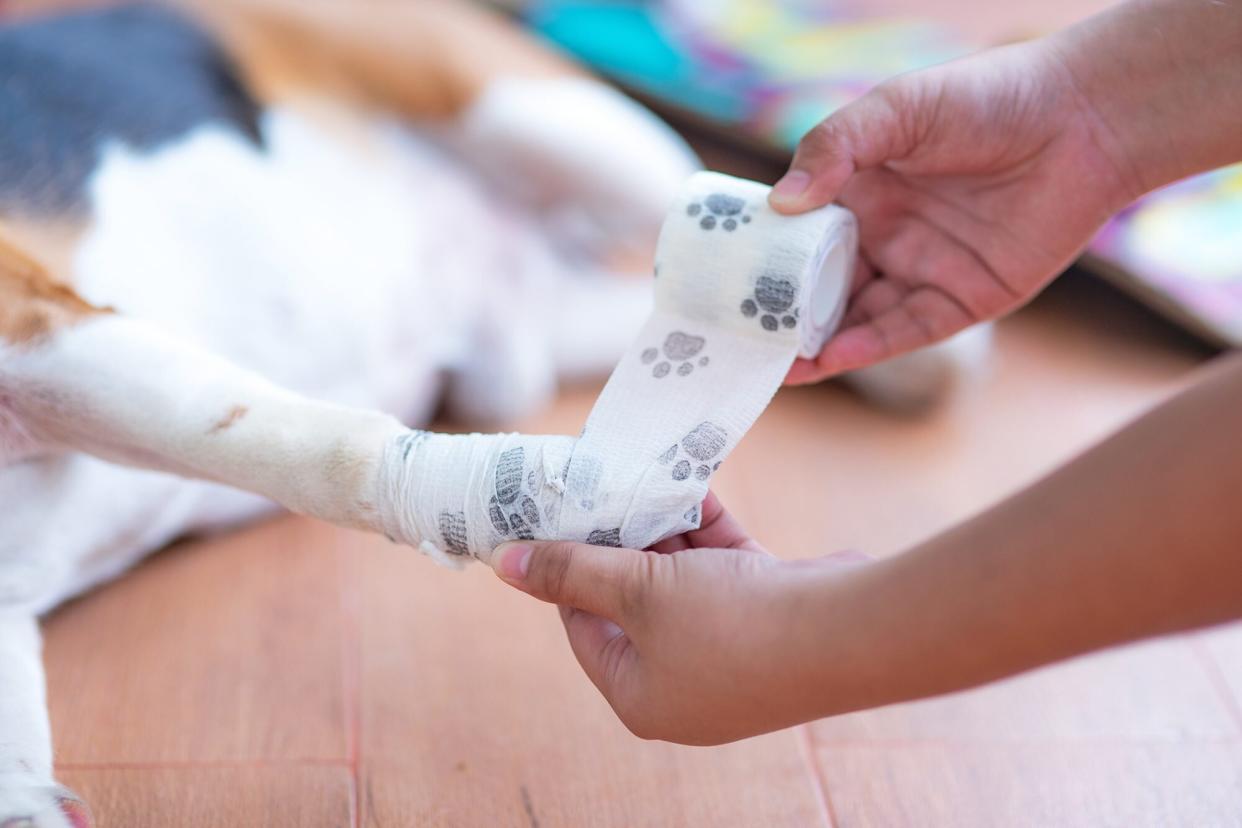Can You Put Neosporin on a Dog? Here's What Our Expert Says

Getty Images
TABLE OF CONTENTS
On This Page
What Is Neosporin?
Can You Put Neosporin on a Dog?
How to Treat Your Dog's Wounds
What to Do if Your Dog Licks Neosporin
If you get a cut or scrape, it's normal to reach for a tube of Neosporin to help you heal. This may lead you to do the same if your dog has a minor wound. But is Neosporin safe for dogs? And can you use other antibiotic topicals on your pup? The answer is maybe—it really depends on a few factors.
What Is Neosporin?
Neosporin is the brand name of a line of topical antibiotic wound care products. These products are intended to treat minor, superficial wounds like cuts and scrapes. You may be most familiar with the original Neosporin ointment, which contains three topical antibiotics in a petroleum base:
Bacitracin zinc
Neomycin sulfate
Polymyxin B sulfate
The topical antibiotics in Neosporin work together to prevent infection, while the base ointment or cream moisturizes the wound to promote healing. Some Neosporin products also contain a topical anesthetic called pramoxine that can reduce pain and itching. Most formulas are also available as topical creams.
You can usually find generic antibiotic ointments or creams with the same or similar ingredients—these may be called "triple antibiotic" ointments or creams. Neosporin and its generic counterparts are available over-the-counter and labeled for use in humans.
Can You Put Neosporin on a Dog?
When used properly, it's generally considered safe to put Neosporin on dogs, and the same goes for generic triple antibiotic topicals. But there are a few caveats.
Any topical applied to a dog will encourage that dog to lick the area. So, applying Neosporin means your dog will likely lick off the medication and ingest it.
Ingesting Neosporin can be problematic. In fact, injectable neomycin has been linked to hearing loss in dogs. Although licking a small amount of the drug may not be enough to cause any issues, it also might not be worth the risk. Additionally, ingesting antibiotics can upset the natural balance of microorganisms in the dog's gut—called the microbiome—potentially leading to diarrhea, vomiting, and other gastrointestinal issues. The amount of active ingredients in Neosporin is low, so licking a little bit is unlikely to harm your dog. However, regular use can lead to GI upset.
Licking wounds can also cause irritation and introduce bacteria into the wound, which delays healing and can lead to infection. Licking can be prevented with an Elizabethan collar, commonly called a cone.
It's also possible for your dog to have an allergic reaction to Neosporin and similar products. The dogs may develop a rash, hives, or facial swelling. Anaphylaxis is a rare reaction, but it's serious and requires immediate veterinary attention.
The general consensus is that dogs don't really benefit from topicals like Neosporin for minor injuries. Many vets find that minor wounds heal fine without topical medications (as long as the dog doesn't lick the area). It's best to clean the wound and call your veterinarian for advice, and avoid applying products like Neosporin unless your vet advises it.
RELATED: Is Hydrocortisone Cream Safe to Use on Dogs? Here's What a Vet Says
How to Treat Your Dog's Wounds
If your dog gets a small cut or scrape, gently clean the area with mild soap and water, then pat the area dry with a clean towel. If the wound is still bleeding, apply pressure for a minute or so. Contact your vet if the bleeding continues, the wound seems deep or severe, or if you notice foreign material in the wound.
Watch the area for the next few days, keeping it clean and dry. Be sure to prevent your dog from licking the area. Visit your vet if the wound continues to look swollen, starts oozing pus or fluid, or seems extremely painful.
RELATED: How to Create a Pet First Aid Kit, According to a Vet
What to Do if Your Dog Licks Neosporin
If you applied a topical like Neosporin and your dog is licking it, clean the area and contact your veterinarian. Fortunately, licking Neosporin is unlikely to cause toxicity in dogs. However, your vet's office can tell you if the wound requires veterinary attention. They can also advise you on what to do if your dog experiences GI effects from ingesting the Neosporin.
If your dog eats a large amount of Neosporin (like the whole tube) immediately contact your local vet, a pet emergency center, or a pet poison control service like ASPCA Animal Poison Control at (888) 426-4435 or Pet Poison Helpline at (855) 764-7661. Your dog may need treatment at a veterinary hospital.

